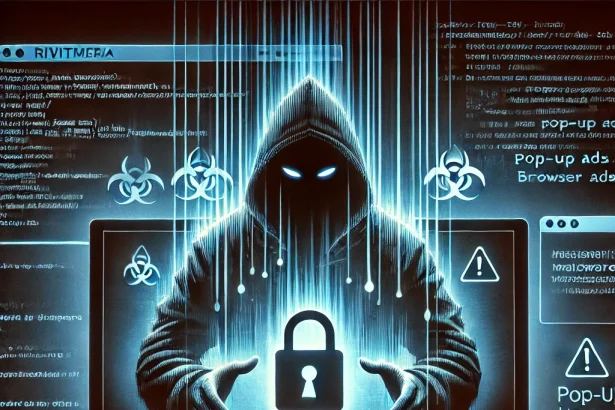RBXReal.click isn’t ransomware or a phishing scam—it’s adware/browser hijacker-type malware that forces pop‑ups, redirects, and deceptive alerts onto your system. It usually gets installed via rogue browser extensions or bundled with free software installs.
Quick Threat Summary
| Feature | Details |
|---|---|
| Threat type | Adware / browser hijacker |
| Associated domain | rbxreal.click (pop-ups & redirects) |
| Detection names | Varies by AV vendor—often flagged as PUA.Adware or BrowserModifier |
| Symptoms | Frequent pop‑ups, redirects, new tabs with ads, slow browsing, unwanted extensions |
| Damage | Annoyance, data tracking for ad revenue, potential exposure to more malicious sites |
| Distribution methods | Bundled software, deceptive updates, shady browser extensions |
| Danger level | Moderate — less dangerous than ransomware, but still invasive |
| Removal tool | Use SpyHunter: SpyHunter Download |
In‑Depth Threat Analysis
How I Got Infected
RBXReal.click typically arrives when users install a free utility or browser extension that silently adds adware. These may bundle unwanted software or prompt fake update warnings. Once the extension is active, it injects pop-ups, redirects to rbxreal.click, and may prompt for notification permissions.
What Does It Do
- Spams pop‑ups and alerts disguised as system notifications or “update” prompts
- Redirects browsing sessions to ad-filled pages
- Collects browsing data for targeted ads
- Leads to other malware or scam pages by pushing users towards untrustworthy sites
Should You Be Worried For Your System
While RBXReal.click won’t encrypt files or steal credentials directly, it degrades your browsing experience and erodes privacy. It also acts as a gateway—one click could land you on a malicious site hosting more harmful malware or phishing attacks.
Manual Removal Guide for Browser Hijackers
Step 1: Uninstall Suspicious Programs (Windows & Mac)
Before resetting your browser, remove any software that may have installed the hijacker.
Windows (10, 11, 8, 7)
- Press
Win + R, typeappwiz.cpl, and hit Enter. - Find Unwanted Applications
- Look for recently installed programs that seem suspicious (e.g., “EasySearch,” “QuickFind,” “Search Manager”).
- Uninstall
- Click on the suspicious program > Select Uninstall > Follow on-screen instructions.
Mac (macOS Ventura, Monterey, Big Sur, Catalina, Mojave, etc.)
- Open Finder and go to Applications.
- Look for unknown or unwanted programs.
- Drag any suspicious apps to the Trash and empty the Trash.
Step 2: Remove Browser Hijacker from Web Browsers
Google Chrome
- Reset Chrome to Default Settings
- Open Chrome > Click ⋮ Menu (top-right corner) > Settings.
- Scroll down and select Reset settings > Click Restore settings to original defaults > Confirm.
- Remove Suspicious Extensions
- Open chrome://extensions/ and remove unknown extensions.
- Change Default Search Engine & Homepage
- Go to Settings > Search engine > Select Google or another trusted search engine.
- Under On Startup, remove any unwanted URLs.
Mozilla Firefox
- Reset Firefox
- Click the Menu (☰) > Select Help > Click More Troubleshooting Information > Refresh Firefox.
- Remove Unknown Extensions
- Open Add-ons Manager (
Ctrl + Shift + A) > Remove any suspicious extensions.
- Open Add-ons Manager (
- Change Search Engine & Homepage
- Open Settings > Search > Choose Google or another safe search engine.
Microsoft Edge
- Reset Edge
- Click ⋮ Menu > Settings > Reset settings > Restore to default values.
- Remove Unwanted Extensions
- Open edge://extensions/ and remove any unfamiliar extensions.
Safari (Mac Only)
- Reset Safari & Clear Data
- Open Safari > Click Safari (top-left menu) > Select Clear History.
- Go to Preferences > Privacy > Click Manage Website Data > Remove All.
- Delete Suspicious Extensions
- Open Safari > Preferences > Extensions > Remove anything unfamiliar.
- Change Homepage & Search Engine
- Open Preferences > General > Change your homepage to a trusted site.
- In Search, set your search engine to Google or a preferred option.
Step 3: Check for Unauthorized System Changes
Windows – Check the Hosts File
- Open Notepad as Administrator (
Win + S, type Notepad, right-click, Run as Administrator). - Click File > Open and navigate to:makefileCopyEdit
C:\Windows\System32\drivers\etc\hosts - If you see unknown IPs or URLs at the bottom, remove them.
- Save changes and restart your computer.
Mac – Check the Hosts File
- Open Terminal (
Command + Space, typeTerminal). - Type:bashCopyEdit
sudo nano /etc/hosts - Look for suspicious entries and delete them.
- Press
Ctrl + X, thenY, thenEnterto save.
Automatic Removal Using SpyHunter (Windows & Mac)
For those who prefer a quick, hassle-free removal process, using SpyHunter is highly recommended.
Step 1: Download SpyHunter
Click here to download SpyHunter: Download SpyHunter
Step 2: Install & Run SpyHunter
- Follow the instructions on the SpyHunter Download Page to install the software.
- Open SpyHunter and run a full system scan.
Step 3: Remove Browser Hijackers
- SpyHunter will detect all malware and potentially unwanted programs.
- Click Fix Threats to remove the detected hijacker.
- Restart your device to complete the cleanup process.
Step 4: Reset Browser Settings (If Necessary)
Even after SpyHunter removes the hijacker, you may need to reset your browser settings manually (refer to browser-specific instructions above).
Preventing Future Browser Hijacker Infections
- Be cautious when installing free software – opt for Custom Installation to avoid bundled malware.
- Avoid clicking on suspicious ads or pop-ups – they often distribute browser hijackers.
- Keep your operating system and software updated – outdated programs are more vulnerable to infections.
- Use a trusted anti-malware tool like SpyHunter to provide real-time protection against threats.
Conclusion
RBXReal.click is a persistent adware/browser hijacker that disrupts browsing with constant pop‑ups and redirects. It’s not as catastrophic as ransomware, but it threatens your privacy and system performance. Removing it ASAP using a reliable anti‑malware tool like SpyHunter is essential for restoring control. Once cleaned, avoid installing software from unknown sources and watch for sneaky browser extensions to stay safe.




